The New Mexico History Museum today played host to a contingent of accurate-to-the-period-dressed representatives of the Sons of the American Revolution. The group arrived eager to see the new exhibit The Threads of Memory: Spain and the United States (El Hilo de la Memoria: España y los Estados Unidos), in particular for its final section’s depiction of Spain’s role in helping the revolutionaries win their war against Great Britain.
That they did so in period style enthralled — and sometimes perplexed — other museum visitors, many of whom did the first thing any modern American thinks of in such situation: Pull out the cell phone and snap a pic.

George C. Garcia, Charles Martinez y Vigil and Gene Tomlinson
Why did they pick today for a visit? With the group’s national president, David Sympson, in town, the time seemed right to see firsthand some of the documents that form their heritage. So, after lunch at the Osteria restaurant, they strolled over to the museum, having stashed their 9-foot lances in a room at the eatery.
“(Deputy Director) John McCarthy told us beforehand, `Don’t bring any weapons,'” said SAR New Mexico President Gene Tomlinson.
He was joined by the Santa Fe Chapter president, Charles Martinez y Vigil, and George C. Garcia. With their brass-buttoned knickers and Zorro-style hats, they were authentic from their 1780 Santa Fe Presidio garb down to their personal DNA. Tomlinson claims an ancestor who fought in the American Revolution; Martinez y Vigil and Garcia claim ancestors who contributed to Spain’s bankrolling of war against the Redcoats.
“If we were to walk in the front doors of the Palace of the Governors,” Tomlinson said, “these uniforms probably haven’t been worn there since 1790.”
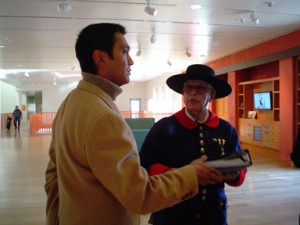
Curator Josef Diaz (left) with George C. Garcia
A primary goal of Threads of Memory is to deepen Americans’ knowledge of just how much muscle Spain exerted in the Americas in the centuries that are often taught from an East Coast perspective. From the earliest explorers in the 1500s, through the establishment of Santa Fe in 1610, the colonization of today’s New Mexico, Florida, Texas and California, and the multi-nation efforts in the American Revolution, Spain has made Americans far more Spanish than many believe they are.
That’s also a goal of the Sons of the American Revolution, which has been reaching out to descendants of all Spanish soldiers to research their lineage and apply for society membership. From the NM Patriot website:
When the American colonies waged a war for independence against England, King Carlos III of Spain sought opportunity to regain land Spain lost to England at the end of the Seven Years War in 1773. Spain agreed to join France as an ally and beginning in 1776, covertly shipped arms, munitions, cattle, uniforms, medicine, blankets, and money to the American colonies using France as the go between. Spain declared war on England in June 1779
In March of 1780, Carlos III decreed that to sustain the war against England, “his vassals in America” were to contribute a one-time donativo (donation) of one peso (approximately $30 by year 2002 standard) per Indian and other castes and two pesos per Spaniard and noble. Collectors (such as alcalde mayores or military commanders) went to towns and pueblos in the New World and collected one peso per Indian over 18 years old and other castes, and two pesos from each Spaniard. Donativos were collected from soldiers and citizens throughout Cuba and Spain’s hard-pressed North American colonies, including the provinces of California, New Mexico, and Texas.
–Robert H. Thonhoff, The Vital Contributions of Spain in the Winning of the American Revolution: An Essay on a Forgotten Chapter in the History of the American Revolution, 2000, (2), self published
The SAR recognizes a variety of ancestral involvement in the war as worthy of membership: service in the Spanish military, the militia, or as Indian auxiliaries; donating money to defray expenses of the war; Spanish cowboys (in Texas) who drove cattle to feed the American colonial troops; and mission priests who led public prayers on behalf of Spain’s support of the American Revolution.
Upon entering the exhibit, the SAR contingent proved themselves true students of history by becoming engrossed not only in the exhibition’s final section, but by creeping through its length, magnifying glasses in hand. We were delighted to welcome them — and just as delighted to give our unsuspecting other visitors an interesting dinner-table tale to share later.

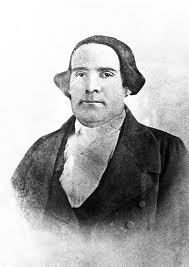
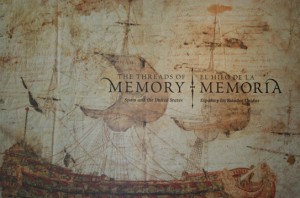 Opening this weekend, The Threads of Memory: Spain and the United States (El Hilo de la Memoria: Espana y los Estados Unidos) weaves the story of Spain’s first 300 years in the Americas. The History Museum marks the U.S. debut of 138 rare and precious documents, maps, illustrations and paintings — but it’s only here until Jan. 9, 2011, so get it on your calendar. (You’ll also enjoy the 12 weeks of lectures, concerts and Chautauqua performances accompanying it; every one of them is free.)
Opening this weekend, The Threads of Memory: Spain and the United States (El Hilo de la Memoria: Espana y los Estados Unidos) weaves the story of Spain’s first 300 years in the Americas. The History Museum marks the U.S. debut of 138 rare and precious documents, maps, illustrations and paintings — but it’s only here until Jan. 9, 2011, so get it on your calendar. (You’ll also enjoy the 12 weeks of lectures, concerts and Chautauqua performances accompanying it; every one of them is free.)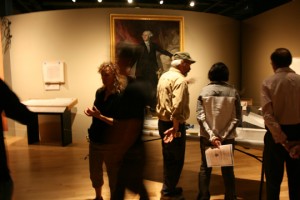 Here, the installation crew buzzes in the part of the gallery where we’ve hung Giuseppe Perovani’s 1796 portrait of George Washington. Many Americans are unaware of the critical role Spain played in helping to win the Revolutionary War. Perovani lived for several years in the United States and, in 1801, with the prestige he had earned, went to Cuba on contract with Archbishop Espejo to help decorate the Cathedral of Havana. He also worked as a teacher there and, afterward, moved back to Mexico, where he became an academic of merit and second director of painting in the Academia de Bellas Artes de San Carlos.
Here, the installation crew buzzes in the part of the gallery where we’ve hung Giuseppe Perovani’s 1796 portrait of George Washington. Many Americans are unaware of the critical role Spain played in helping to win the Revolutionary War. Perovani lived for several years in the United States and, in 1801, with the prestige he had earned, went to Cuba on contract with Archbishop Espejo to help decorate the Cathedral of Havana. He also worked as a teacher there and, afterward, moved back to Mexico, where he became an academic of merit and second director of painting in the Academia de Bellas Artes de San Carlos.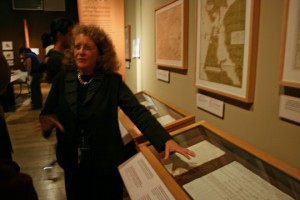 Dr. Frances Levine (left), director of the museum, points to and talks about one of her favorite pieces in the exhibit,a 1786 agreement, hand-written in the Palace of the Governors, between
Dr. Frances Levine (left), director of the museum, points to and talks about one of her favorite pieces in the exhibit,a 1786 agreement, hand-written in the Palace of the Governors, between 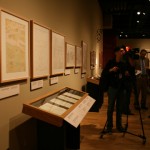 Some of the media members who came to our preview was the
Some of the media members who came to our preview was the  Among EF’s interviews was one with
Among EF’s interviews was one with 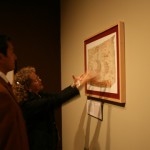 Dr. Levine and Josef Diaz, the museum’s curator of Southwest and Mexican Art and History, examine an illustration of La Belle. The image is the main “brand” of the exhibit; see it above as part of the exhibit title.)
Dr. Levine and Josef Diaz, the museum’s curator of Southwest and Mexican Art and History, examine an illustration of La Belle. The image is the main “brand” of the exhibit; see it above as part of the exhibit title.)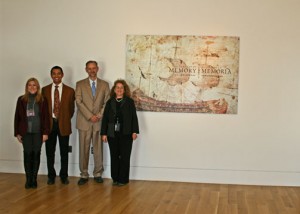 Josef Diaz; Mayor Coss; and Dr. Levine.
Josef Diaz; Mayor Coss; and Dr. Levine.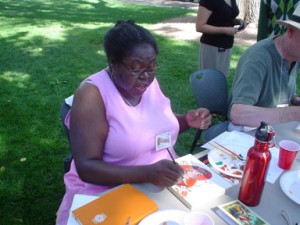 The Palace Courtyard was cool, with a reasonable amount of shade this morning — a far cry from the lightning storm predicted for later today. A perfect time, in short, to try out a little plein air painting, New Mexico-style. The teachers participating in this week’s
The Palace Courtyard was cool, with a reasonable amount of shade this morning — a far cry from the lightning storm predicted for later today. A perfect time, in short, to try out a little plein air painting, New Mexico-style. The teachers participating in this week’s 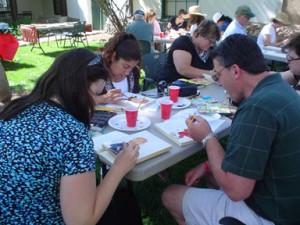
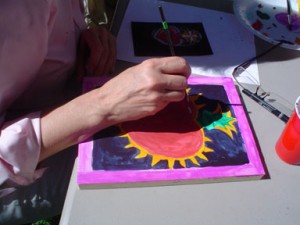
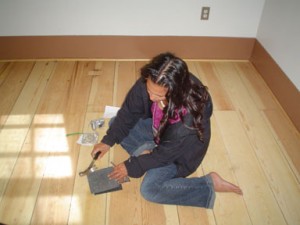
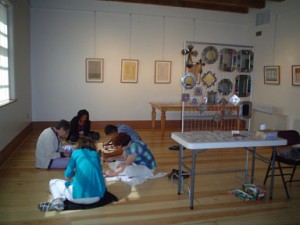
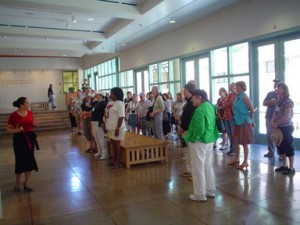
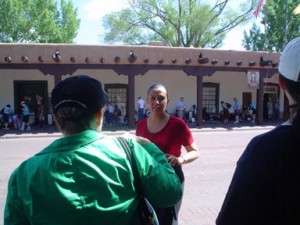
 For as long as people have called New Mexico home, they have pulled gems and minerals from its soil. Today, that tradition yields oil, gas, coal, uranium, and always, the gems that decorate our jewelry. Primary among those gems is a a hydrated phosphate of copper and aluminum known worldwide as turquoise.
For as long as people have called New Mexico home, they have pulled gems and minerals from its soil. Today, that tradition yields oil, gas, coal, uranium, and always, the gems that decorate our jewelry. Primary among those gems is a a hydrated phosphate of copper and aluminum known worldwide as turquoise. According to a New York newspaper: That is a turquoise far and away the finest in America, and it came from these new mines in New Mexico. It is worth $4,000. … (I)t is probable that gems to the value of $200,000 a year may be obtained from this mine. Kunz recognized the possibilities of further branding the Tiffany Blue color by maintaining almost-exclusive rights to the turquoise he had made suddenly valuable.
According to a New York newspaper: That is a turquoise far and away the finest in America, and it came from these new mines in New Mexico. It is worth $4,000. … (I)t is probable that gems to the value of $200,000 a year may be obtained from this mine. Kunz recognized the possibilities of further branding the Tiffany Blue color by maintaining almost-exclusive rights to the turquoise he had made suddenly valuable.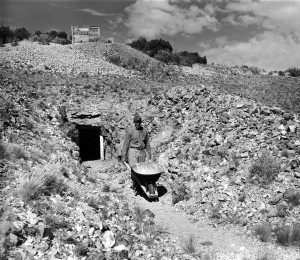
 The Gem & Mineral Show, in conjunction with the Palace of the Governors Native American Artisan Program, allows gem and mineral dealers and Native American artisans to tell their unique stories about the historical relationships that have existed between Native silversmiths and jewelers, miners, and gem and mineral traders.
The Gem & Mineral Show, in conjunction with the Palace of the Governors Native American Artisan Program, allows gem and mineral dealers and Native American artisans to tell their unique stories about the historical relationships that have existed between Native silversmiths and jewelers, miners, and gem and mineral traders.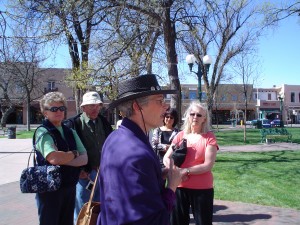 “The Italians did not have tomato sauce,” declared Pat Kuhlhoff. “The Swiss did not make chocolate. And there was never a potato famine in Ireland until Christopher Columbus discovered the Americas.”
“The Italians did not have tomato sauce,” declared Pat Kuhlhoff. “The Swiss did not make chocolate. And there was never a potato famine in Ireland until Christopher Columbus discovered the Americas.”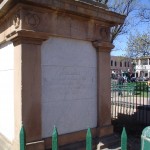 Standing in the Plaza, Kuhlhoff points to the obelisk commemorating those who died in the so-called Indian wars. She tells of how the word “savage” was chiseled out of its inscription –
Standing in the Plaza, Kuhlhoff points to the obelisk commemorating those who died in the so-called Indian wars. She tells of how the word “savage” was chiseled out of its inscription – 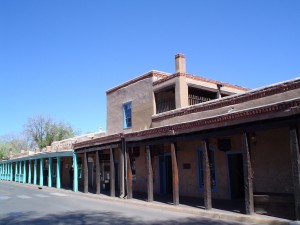 On the corner of Cathedral and Palace, she compares and contrasts Territorial, Pueblo, Mission and Romanesque architectural styles.
On the corner of Cathedral and Palace, she compares and contrasts Territorial, Pueblo, Mission and Romanesque architectural styles.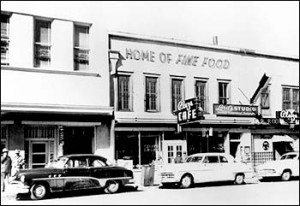 The
The  “The Cowden Café will be like a little café bistro,” said Daniel Razatos. “You come in for a little snack, nothing’s very huge or expensive, and it’s a nice, comfortable atmosphere to hang out and read your newspaper – very European.”
“The Cowden Café will be like a little café bistro,” said Daniel Razatos. “You come in for a little snack, nothing’s very huge or expensive, and it’s a nice, comfortable atmosphere to hang out and read your newspaper – very European.”